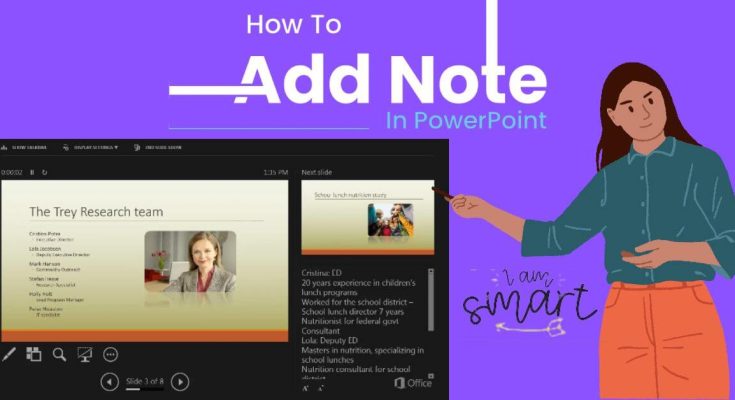1. How to Add Notes to PowerPoint Presentation – An Introduction
How to add notes to PowerPoint presentations has become everyone’s question owing to its effectiveness. Adding notes is a very powerful trick to be precise in a presentation. You are aware that PowerPoint is a powerful tool that allows users to create visually appealing and informative presentations. But while crafting a compelling slideshow, it is essential to include additional information or reminders that aid in delivering a seamless presentation. This is where PowerPoint’s “Notes” feature comes into play.
The “Notes” feature in PowerPoint enables presenters to attach supplementary information, explanations, or speaking points to each slide. These notes are not visible to the audience during the actual presentation, making them an invaluable tool for maintaining a smooth flow and ensuring you don’t miss any critical points.
In this guide, we will walk you through the step-by-step process of adding notes to your PowerPoint presentations. Whether you are a beginner or an experienced presenter looking to enhance your slides, understanding how to effectively utilize this feature will undoubtedly elevate the quality of your presentations.
So, let’s dive in and discover how to add and make the best use of notes in your PowerPoint presentations!
2. How To Add Notes To Your PowerPoint Slides: 8 Easy Steps
Sure, here’s a step-by-step guide on how to add notes to your PowerPoint slides:
Step 1: Open Microsoft PowerPoint
Launch Microsoft PowerPoint on your computer. You can find it in the Start menu (Windows) or in the Applications folder (Mac).
Step 2: Create or Open a Presentation
Either create a new presentation or open an existing one that you want to add notes to. To create a new presentation, click on “Blank Presentation” or select a template from the available options.
Step 3: Switch to Notes Page View
In PowerPoint, there are different views for your presentation. To add and view notes, switch to the “Notes Page” view. You can do this by clicking on the “View” tab in the top menu, then selecting “Notes Page” from the Presentation Views group.
Step 4: Add Notes to a Slide
Once you are in the “Notes Page” view, you’ll see a large area below each slide where you can type your notes. Click on the text box labeled “Click to add notes” or simply click anywhere in the notes area for the slide you want to add notes to.
Step 5: Type Your Notes
Start typing your notes in the notes area. You can add any additional information, reminders, key points, or cues that you want to refer to during your presentation. The notes area is not visible during the slideshow but serves as a reference for the presenter.
Step 6: Move to the Next Slide
To add notes to the next slide, click on the slide thumbnail in the left-hand pane. This will switch you to the notes area for the next slide, and you can continue adding notes.
Step 7: Save Your Presentation
Make sure to save your presentation to keep all the notes you’ve added. Go to “File” in the top menu, then select “Save” or “Save As” to save your PowerPoint file to your desired location on your computer.
Step 8: Exit Notes Page View
After you’ve added notes to all the slides, you can exit the “Notes Page” view and return to the normal view. Click on the “View” tab in the top menu and select “Normal” or “Slide Sorter” view, depending on your preference.
That’s it! You’ve successfully added notes to your PowerPoint slides. When you present your slideshow, you can refer to the notes you’ve added in the “Notes Page” view to assist you during your presentation.
3. The Importance Of Note-Taking In PowerPoint Presentations
Adding notes to PowerPoint presentations is an essential practice that offers several benefits to both the presenter and the audience. Here are some reasons highlighting the importance of including notes in your PowerPoint slides:
1. **Enhanced Speaker Support**: Notes act as a personal script for the presenter, providing additional information, key points, and reminders about the content on each slide. This support reduces the likelihood of forgetting important details and helps maintain a smooth flow during the presentation.
2. **Increased Audience Engagement**: Well-crafted notes can help presenters stay on track and maintain a conversational tone, which can enhance audience engagement. When speakers feel confident and knowledgeable about the subject, their enthusiasm tends to be contagious, making the presentation more enjoyable for the listeners.
3. **Comprehensive Handouts**: Sharing presentations with notes after the session can serve as comprehensive handouts for the audience. These notes act as a useful reference, reinforcing the main ideas and allowing the audience to revisit the content at their own pace.
4. **Accessibility and Inclusivity**: Including notes makes the presentation more accessible and inclusive for all participants. Individuals with visual or hearing impairments, for instance, can benefit from the extra information in the notes section.
5. **Backup and Reusability**: Notes serve as a backup plan in case of technical difficulties or unforeseen interruptions during the presentation. Moreover, presenters can reuse the slides and notes in different contexts or adapt them for other presentations, saving time and effort in the long run.
6. **Supporting Visual Content**: In some cases, slides may contain only visuals or graphics without much text. Notes become crucial in these situations, as they provide the context and explanation behind the visuals, ensuring the audience grasps the intended message.
7. **Maintaining Focus and Structure**: Notes help presenters stay focused on the main points and the overall structure of the presentation. They act as a roadmap, guiding the speaker through the content and ensuring a logical flow from one slide to the next.
8. **Effective Training Tool**: For training sessions or workshops, notes can be invaluable in providing additional information, examples, or anecdotes that enrich the learning experience. They also help trainers remember critical talking points and maintain consistency across multiple sessions.
9. **Professionalism and Credibility**: Providing a well-prepared presentation with thorough notes demonstrates professionalism and credibility. It shows that the presenter has invested time and effort in delivering a thoughtful and well-organized presentation.
10. **Minimizing Information Overload**: Including comprehensive information in the notes section allows presenters to avoid cluttering the slides with excessive text. This helps prevent information overload, ensuring that the audience can digest the content more effectively.
In conclusion, adding notes to PowerPoint presentations is a simple yet powerful practice that can significantly improve the overall quality and impact of the presentation. They support the presenter, engage the audience, and provide valuable reference material, making the entire experience more meaningful and enjoyable for everyone involved.
4. How To Organize And Format Your Notes Effectively
Organizing and formatting your notes effectively in a PowerPoint presentation can greatly enhance the clarity and impact of your message. Below are the most essential tips to assist you do that:
1. **Create an Outline**: Before diving into the presentation, create a clear outline of the key points you want to cover. This will help you maintain a logical flow and structure throughout the presentation.
2. **Use Bullet Points**: Keep your notes concise by using bullet points. Each bullet should represent a main idea or subtopic, making it easy for you to remember and present the content.
3. **Maintain Consistency**: Stick to a consistent font type, size, and color for your notes. This will make it easier for you to read during the presentation and ensure a uniform look for your slides.
4. **Keep it Simple**: Avoid writing long paragraphs in your notes. Use short sentences or phrases that capture the main points. Your slides should be the visual aid, not a script.
5. **Highlight Key Information**: Use bold or italics to emphasize important keywords or phrases in your notes. This will help you quickly identify crucial information during the presentation.
6. **Add Visual Cues**: Include visual cues or mnemonic devices in your notes to trigger your memory about specific examples, statistics, or anecdotes you want to share.
7. **Color Code**: If there are different sections or topics in your presentation, consider using color-coding for your notes to help you quickly find the relevant information.
8. **Practice with Slides**: As you create your notes, practice with the actual slides to ensure that the content aligns well with the visual elements.
9. **Include Slide Numbers**: Add slide numbers in your notes to easily keep track of where you are in the presentation.
10. **Leave Room for Improvisation**: While organizing your notes is important, don’t be too rigid. Allow some flexibility to adapt to the audience’s responses or questions.
11. **Consider Speaker Notes**: In PowerPoint, you can use the “Speaker Notes” function to type your notes separately from the slides. This keeps the main slides clean while providing you with detailed notes.
12. **Rehearse Regularly**: Practice your presentation with your notes to ensure you are comfortable with the content and flow.
13. **Use Visuals Strategically**: If there are complex concepts, use visuals, charts, or diagrams in your slides to support your understanding during the presentation.
14. **Avoid Reading Word-for-Word**: Your notes should serve as reminders, not a script to read verbatim. Speak in a natural way and connect with your audience.
15. **Proofread Your Notes**: Before the presentation, review and proofread your notes to correct any errors and ensure clarity.
Remember, effective notes in a PowerPoint presentation should assist you in delivering a compelling talk rather than being the primary focus. By organizing your notes thoughtfully, you can confidently share your knowledge and ideas with your audience.
Funny PowerPoint Night Ideas: Your Quick Guide
5. How To Use Notes Effectively During Your Presentation
Using notes effectively during a PowerPoint presentation can be a valuable aid to keep you on track and ensure a smooth delivery. Follow these below tips on how to achieve it:
1. **Prepare a Clear Outline:** Before creating your PowerPoint slides, outline the main points and structure of your presentation. This will help you organize your thoughts and determine what information you need in your notes.
2. **Use Keywords and Bullet Points:** Instead of writing full sentences in your notes, use keywords and bullet points to jog your memory about the key ideas and talking points for each slide.
3. **Keep Notes Concise:** Avoid writing lengthy paragraphs in your notes. The goal is to provide quick reminders, not to read directly from the script. Keep the information short and of course to the point.
4. **Print or Write Clearly:** If you prefer physical notes, print them out in a large, legible font. If you’re using handwritten notes, make sure your writing is neat and easy to read.
5. **Number the Slides and Notes:** To ensure your notes correspond to the correct slide, number your notes and match them with the slide numbers in your PowerPoint presentation.
6. **Highlight Important Details:** Use highlighting or bold text to emphasize crucial points or sections that require extra attention during your presentation.
7. **Practice, Practice, Practice:** Familiarize yourself with your presentation and notes by practicing multiple times. This will build your confidence and reduce the need to rely heavily on your notes.
8. **Utilize Presenter View:** PowerPoint offers a “Presenter View” option that displays your notes on one screen while the audience sees only the slides on the main screen. This feature allows you to reference your notes discreetly.
9. **Maintain Eye Contact:** When delivering your presentation, try to maintain eye contact with your audience as much as possible. Glancing at your notes occasionally is acceptable, but avoid reading from them constantly.
10. **Be Flexible:** While notes are helpful, don’t be afraid to deviate slightly from them if the situation calls for it. Be prepared to answer questions or provide additional information without solely relying on your notes.
11. **Engage with the Audience:** Interact with your audience, and focus on conveying your message rather than following your notes rigidly. Engaging the audience will help you stay connected and make the presentation more memorable.
12. **Practice Timing:** Practice with your notes to ensure that your presentation fits within the allocated time. Being mindful of time will help you avoid rushing through or running out of content.
By using notes effectively, you can enhance your presentation skills, maintain a smooth flow, and ensure that your message is delivered clearly and confidently to your audience.
6. How To Share And Export Your PowerPoint Presentation With Included Notes
To share your PowerPoint presentation with included notes, First save the PowerPoint file and now, you have a few options depending on how you want to distribute it and what version of PowerPoint you are using. Here are the steps for the most common methods:
**1. Share as a PowerPoint file:**
If you want to share the presentation with someone who has Microsoft PowerPoint, you can simply save the file with the notes included.
– Open your PowerPoint presentation.
– Click on “File” in the top left corner.
– Click “Save As” or “Save a Copy.”
– Select the location where you like to save your file.
– In the “Save as type” dropdown, select “PowerPoint Presentation (*.pptx).”
– Click on the “Save” button.
– Now, your PowerPoint presentation with the notes is saved and ready to be shared.
**2. Share as a PDF file:**
If you want to share the presentation with someone who may not have PowerPoint or to ensure the formatting remains consistent, you can save it as a PDF with notes.
– Open your PowerPoint presentation.
– Click on “File” in the top left corner.
– Click “Save As” or “Save a Copy.”
– Select the location where you like to save the file as PDF.
– In the “Save as type” dropdown, select “PDF (*.pdf).”
– Click on the “Options” button (usually located in the bottom right corner).
– Find the “Publish Options” section, select “Notes Pages” under “Publish what.”
– Click on the “OK” button.
– Click on the “Save” button.
Now, you have a PDF file that includes the slides along with their corresponding notes.
**3. Share via OneDrive or SharePoint (Office 365):**
If you have an Office 365 subscription and use OneDrive or SharePoint, you can share the presentation online and give access to specific individuals. This method allows them to view the presentation with notes in a web browser.
– Upload your PowerPoint presentation to your OneDrive or SharePoint account.
– Put the mouse pointer on the uploaded file and Right-click and then select “Share.”
– Set the appropriate sharing settings (e.g., anyone with the link, specific people, etc.).
– Optionally, you can choose whether the recipients can edit or only view the presentation.
– Click on “Apply” or “Send.”
The recipients will receive a link to access the presentation online, which will include the notes.
**4. Share via Email:**
If you want to share the presentation with a limited number of recipients, you can send it via email as an attachment.
– Write a new email in your preferred email which is most suitable for this purpose.
– Attach the PowerPoint file with the notes to the email.
– Write a message and include any necessary instructions.
– Send the email to the recipients.
Please note that if the PowerPoint file is too large, some email providers might have limitations on the attachment size. In such cases, consider using other file-sharing services like Google Drive, Dropbox, or OneDrive to share the file.
By following these steps, you can easily share your PowerPoint presentation with the included notes with others, ensuring they have access to the valuable information you’ve added in your notes.
7. Concluding Remarks: How To Add Notes To PowerPoint Presentation
In conclusion, incorporating notes into your PowerPoint presentation can significantly enhance its effectiveness and impact. By including concise and relevant notes, you provide valuable context and insights that complement the visual content on your slides. These notes serve as a guide for you, the presenter, ensuring that you stay on track and cover all essential points during your talk.
Remember to keep your notes clear and organized, avoiding excessive text and maintaining a logical flow. Bullet points or short sentences are often more effective than lengthy paragraphs. This approach allows you to glance at your notes quickly without losing your audience’s attention.
Furthermore, practice is key. Familiarize yourself with the content and rehearse your presentation multiple times. This practice will help you feel more confident and natural while delivering your talk, minimizing the need to read from your notes constantly.
Lastly, engage with your audience and maintain eye contact as much as possible. While notes are helpful, establishing a connection with your listeners is crucial for effective communication. Strike a balance between referring to your notes and engaging with your audience to deliver a compelling and memorable presentation.
In summary, well-crafted and practiced notes can be a powerful tool to support your PowerPoint presentation and make it a successful communication tool. Utilize them wisely, and you’ll be well on your way to delivering an impactful and engaging talk. Good luck!




